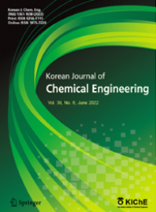Overall
- Language
- English
- Conflict of Interest
- In relation to this article, we declare that there is no conflict of interest.
- Publication history
-
Received October 31, 2023
Accepted December 8, 2023
-
 This is an Open-Access article distributed under the terms of the Creative Commons Attribution Non-Commercial License (http://creativecommons.org/licenses/bync/3.0) which permits
unrestricted non-commercial use, distribution, and reproduction in any medium, provided the original work is properly cited.
This is an Open-Access article distributed under the terms of the Creative Commons Attribution Non-Commercial License (http://creativecommons.org/licenses/bync/3.0) which permits
unrestricted non-commercial use, distribution, and reproduction in any medium, provided the original work is properly cited.
Most Cited
Spartina anglica -Derived Carbon-Coated PE Separator for Physically Restraining Polysulfi de Migration in Lithium-Sulfur Batteries
https://doi.org/10.1007/s11814-024-00060-1
Abstract
Lithium–sulfur batteries (LSBs) have received substantial interest because their theoretical energy density is considerably
higher than that of conventional lithium-ion batteries. However, the diffi culty in confi ning the soluble intermediate polysulfi
de (PS) species of LSBs hinders the prolonged cycling of the cell. In this study, a Spartina anglica -derived carbon-coated
polyethylene (PE) separator (SC-coated PE separator), which can confi ne the PS species on the cathode side, is developed
to improve the cycling retention of LSBs. Spartina anglica , which is considered a predominant marine waste, is converted
to task-specifi c carbon materials via size-controlled milling and carbonization, and is embedded on a PE separator through
a simple casting process. The SC-coated PE separator improves the electrolyte affi nity, which is characterized by measuring
the contact angle, electrolyte uptake, and transference number of Li + ; consequently, the migration of Li + is undisturbed in
the cell, even if an additional layer is formed on the PE separator. Based on the electrochemical performance, the SC-coated
PE separator exhibits a higher initial specifi c capacity than the PE separator, in addition to a remarkably increased cycling
retention (65.3% vs. 27.7%) after 100 cycles. The SC-coated PE separator eff ectively inhibits the PS species through physical
absorption, thereby increasing the utilization of the active sulfur species. Moreover, the SC-coated PE separator presents a
relatively stable interfacial morphology of the cycled Li anode, revealing that the comprehensive interfacial stability of the
Li–S cell is enhanced by eff ectively confi ning the PS species in the cell.

